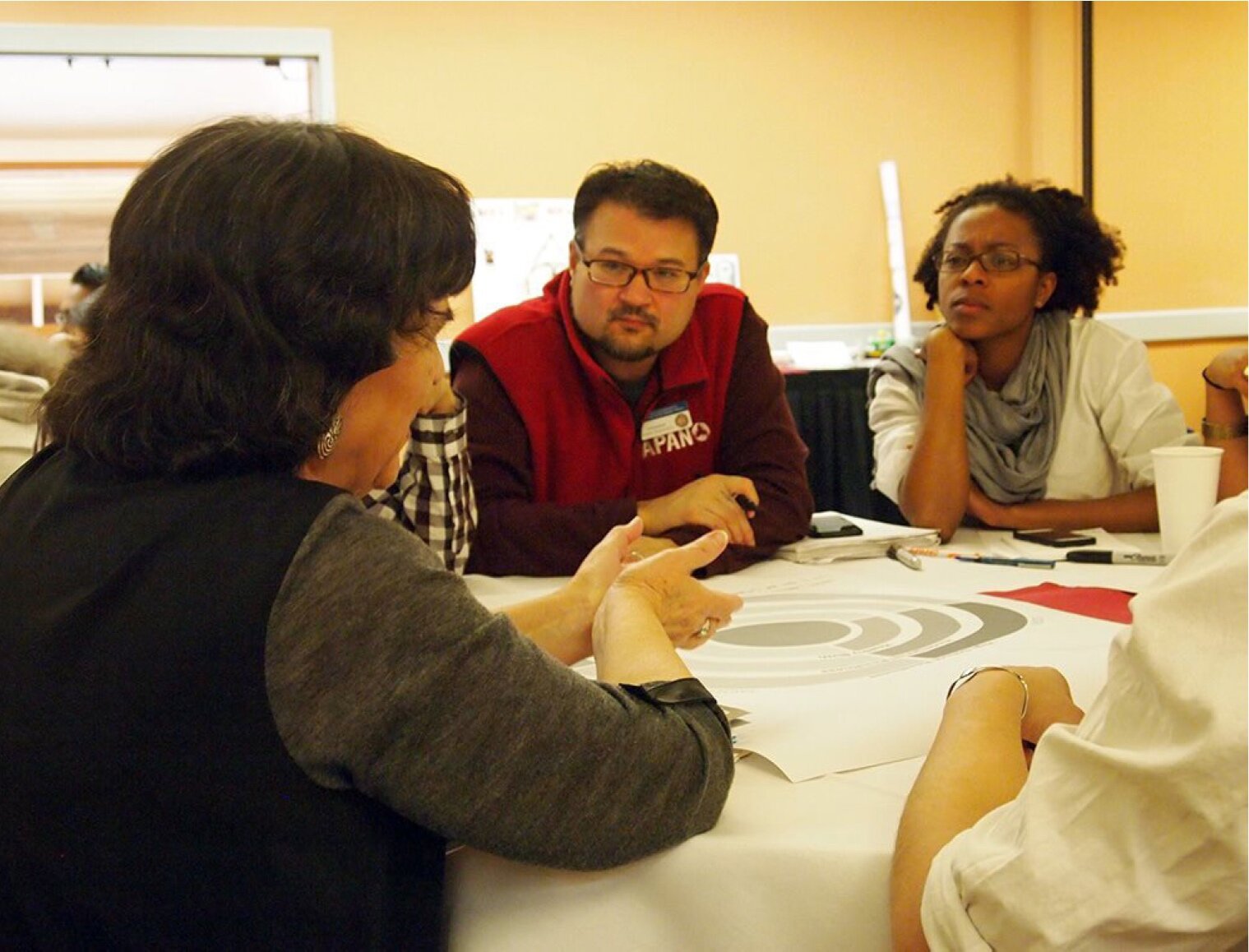How the Healthy Beginnings+Healthy Communities Initiative Evolved from 2015 through 2020
With a multi-year initiative, change is inevitable. New leaders are elected to office, policies are passed and repealed, and nonprofit staff members transition to different roles. Organizations merge and dissolve. Some opportunities arise, and others disappear.
Over the course of our six-year Healthy Beginnings+Healthy Communities initiative, we experienced all of this and more. The initiative and our grantees pivoted time and again, responding to crises and shifts in public interest.
This is how HB+HC evolved from 2015 through 2020:
Where We Began
When we first called for applications for HB+HC’s Organizing Grant Year, we created a dashboard of metrics to measure positive improvements in health. We called this dashboard the Health Compass. It included milestones for health at birth, kindergarten and high school. It also recognized four dimensions of health: social, mental, spiritual and physical.
At our Organizing Grant Year gatherings in 2015, participants filled in blank Health Compasses with their own milestones. They wrote in milestones like “culturally specific services to prepare parents,” “all children have access to healthcare,” and “access to safe places to congregate and play.” They also participated in workshops about NEAR (Neuroscience, Epigenetics, ACEs, Resilience) science, health system transformation, and coalition building.
At the end of the Organizing Grant Year, ten Community Collaboratives continued on to participate in the full initiative:
APANO VOTE Network, led by Asian Pacific American Network of Oregon
Successful Transitions, led by Southern Oregon Education Service District (later transitioned into Criminal Justice Coalition, led by Unite Oregon Rogue Valley)
Eastern Oregon Latino Alliance for Children and Families, led by EUVALCREE
Healthy CAPACES, led by Pineros y Campesinos Unidos del Noroeste
Healthy Communities, Healthy Futures, led by Healthy Living Collaborative of Southwest Washington (left the HB+HC initiative after folding into SWACH)
Immigrant and Refugee Engage Project, led by Immigrant and Refugee Community Organization
La Voz de la Comunidad, led by Consejo Hispano (formerly Lower Columbia Hispanic Council)
Let’s Talk Diversity Coalition, led by Let’s Talk Diversity Coalition (disbanded)
Racial Equity Agenda, led by Coalition of Communities of Color
Youth Equity Collaborative, led by Momentum Alliance
Building Power for Kids & Families
During our first official year of Communities Collaborate, we dug deep to understand what it means to build power as communities. HB+HC’s emphasis shifted toward BIPOC communities taking seats at decision-making tables.
In fall 2016, Collaboratives designed and participated in a “Building Power Assessment.” This included questions about organizing models, frameworks, movements, policy agendas and public policy influence, coalitions and networks, campaigns, communications, leadership development, fundraising, legal tools and electoral politics.
The assessment illuminated something we already suspected: different Collaboratives possessed different strengths, and all Collaboratives were more confident in some areas than others. This led us to recognize an opportunity for Collaboratives to share skills with one another. Collaboratives held trainings for one another on fundraising, youth leadership, communications and more. Some Collaboratives even visited each other, community-to-community, to share knowledge.
Changing Political Landscape
The results of the November 2016 election, both locally and nationally, put many of the Collaboratives into defense mode, especially those who counted immigrants and refugees among their staff, board and community members. Organizations hosted Know Your Rights trainings and advocated for cities and school districts to pass statements of sanctuary and inclusion. Throughout their time together, the Collaboratives defended immigrants’ rights through defeating anti-immigrant ballot measures. They also campaigned for progressive policies like Ethnic Studies in Oregon schools, affordable housing measures and healthcare for all children.
How We Worked Together
Gatherings
Every year of HB+HC, except 2020, we held one to three Cohort gatherings. At the three-day gatherings, representatives from each Collaborative spent time building relationships with each other, leading and attending workshops to learn relevant concepts and skills, and being inspired by keynote speakers from across the country. Each Collaborative was responsible for hosting one gathering, and time was also spent visiting people and places in the community and learning about each other’s work.
We held gatherings in Warm Springs, Woodburn, Salem, Medford, Portland, Astoria and Ontario, Oregon, as well as Vancouver and Kelso/Longview, Washington. We did everything from door-to-door canvassing for issue campaigns to riding public buses for a city-wide scavenger hunt. We covered a myriad of topics in keynotes, workshops and conversations, including the history of the Chinese Exclusion Act in Oregon, disability justice, Oregon’s Black history, combating anti-Blackness, how to use the Voter Activation Network, communications skills, parent leadership and so much more.
Leadership Team
In 2017, we formed the Cohort Leadership Team. This group was made up of key representatives from each Collaborative. Together, they suggested content for gatherings, made decisions for shared Cohort action and held each other accountable.
The Leadership Team met about once a quarter to discuss strategies. They also convened annually in a longer retreat format to build stronger bonds and develop the following year’s Cohort action priorities. The leadership team was responsible for bringing the Cohort Action Plan back to their communities and deciding what to lead on and what to support.
Cohort Action Plan
The Cohort Action Plan included four focus areas:
Narrative - The Cohort chose to contribute to a new narrative about communities of color in Oregon to unite communications efforts around advocacy and political campaigns.
Leadership Development - Collaboratives wanted to assess existing leadership development programs and determine gaps they could help fill in.
Policy Advocacy - Collaboratives worked together to support policy campaigns each year. For example, the Cohort successfully campaigned for the Equal Access to Roads Act and the Oregon Voting Rights Act during the 2019 Legislative Session.
Electoral Organizing - Collaboratives supported candidates and ballot measures for general and special elections, including state and school board races.
Collaboratives participated in Cohort Action in various ways. Some contributed staff time to work on campaigns. Others brought community members from across the state to lobby in Salem. The Cohort Action Plan allowed Collaboratives to participate in Cohort-level actions in any number of ways, depending on what aligned with their Collaborative-level interest, capacity and goals. While we saw some success in the Cohort Action Plan, we realized it was very challenging to juggle four sometimes separate, sometimes overlapping priorities. Additionally, because of the limitations of 501(c)(3) organizations and political work, some Collaboratives were not able to contribute directly. Other times, people working on Cohort Action were not able to coordinate their efforts to accomplish their intended goals.
501(c)(4) Funding
Unique among other foundations, NWHF has the ability to grant 501(c)(4) dollars, as well as 501(c)(3) dollars. Throughout the initiative, HB+HC Collaboratives had the option to request 501(c)(4) funding alongside 501(c)(3) funding. In 2016, just one Collaborative, Healthy CAPACES, received 501(c)(4) funding. In 2020, five Collaboratives requested and received 501(c)(4) funding: Healthy CAPACES, APANO VOTE Network, Racial Equity Agenda, Criminal Justice Coalition and Eastern Oregon Latino Alliance for Children and Families. 501(c)(4) funds have allowed these Collaboratives to ramp up their lobbying and electoral organizing.
2020 Crises and Opportunities
The COVID-19 pandemic, renewed social uprising against police killings of Black people, and wildfires all introduced unexpected hurdles and windows to opportunity. For instance, the Collaboratives involved in the #WeCountOregon 2020 Census campaign were forced to adjust their outreach plans after COVID-19 broke out in the U.S. Previously, outreach plans prioritized door knocking and in-person events. In March and April, the campaign quickly pivoted to online and phone-based outreach. Another example: The national social uprising catalyzed by a police officer murdering George Floyd renewed political attention and interest in Black Lives Matter movement policy demands. This presented an opportunity for Portland organizations and activists to bring a community oversight measure to the November ballot, which passed with more than 80% of voters in support.
Conclusion
We’re far from where we started with HB+HC. For one, we’re not ending the initiative asking Collaboratives to tell us if they met the measures set in the Health Compass. It’s not that we no longer believe these metrics to be important; we do. Rather, we’ve come to recognize that the same set of measures aren’t meaningful in every community. Communities define health in different ways. We’ve also realized that building power through narrative change, leadership development, policy advocacy, and electoral organizing is a long-term strategy with much farther reaching benefits than are easy to measure. Only time will show how these efforts improve health.






